Photos by Eiichi Matsumoto: The Destroyed City
|
|
An Asahi reporter and Matsumoto went to Hiroshima and Nagasaki to take photos. They photographed Nagasaki from August 25 to September 15, then headed for Hiroshima. However, the trains were stopped because of the Makurazaki Typhoon, so they traveled to the city by boat and on foot. They stayed in Hiroshima from September 18 to 25. Because Matsumoto took these A-bomb damage photos for the Scientific
Asahi, virtually all directly focus on damaged buildings. Matsumoto entered Hiroshima as a newspaper photographer subject to media constraints on showing ghastly images of human bodies. One photo taken by Matsumoto led to the prefecture digging for and finding human remains in Shukkeien Garden in July 1987.
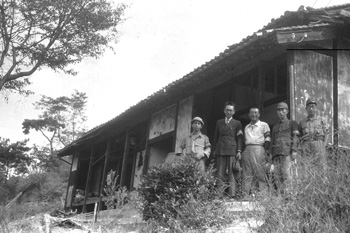 |
| 37 |
| Eiichi Matsumoto to far right. Gion-cho, Asa-gun (now, Asaminami Ward, Hiroshima City). Photo taken at dormitory of Asahi Shimbun Hiroshima Bureau.
|
|
 |
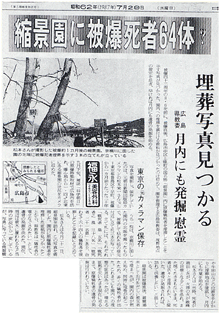 |
| 38 |
Newspaper article on the unearthing of human remains
Chugoku Shimbun; July 29, 1987
|
|
|
| The Hypocenter and Vicinity |
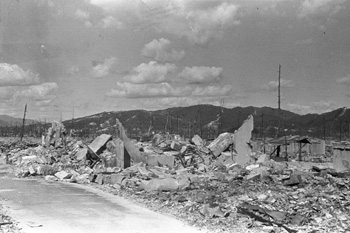 |
| 39 |
Shima Hospital
The hypocenter, Saiku-machi (now, Ote-machi 1-chome)
|
|
The piles of rubble that had been Shima Hospital. The atomic bomb exploded approximately 600 meters above this hospital. Its one-meter thick walls were designed to withstand any sort of attack, but they were no match for the atomic bomb. Approximately 75 patients and hospital staff perished with the building.
|
|
 |
Motoyasu Bridge
Approx. 130m from the hypocenter, Nakajima-hon-machi (now, Nakajima-cho)
|
|
Looking toward the hypocenter from west end of Motoyasu Bridge. The girders stood up to the bomb, but the handrails were toppled into the river. The coping stones on top of the newels were pushed off to the right or left, in opposite directions. Thus, the hypocenter was thought to be a point straight off the end of this bridge.
|
| 40 |
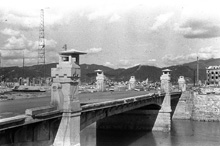 |
|
|
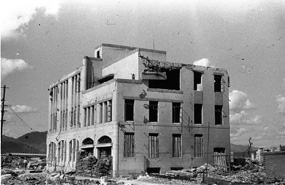 |
| 41 |
The Fuel Hall
Approx. 170m from the hypocenter, Nakajima-hon-machi (now, Nakajima-cho)
|
|
Built to be a kimono store, it was used by the Hiroshima Prefectural Fuel Rationing Union at the time of the bombing. In 1957, Hiroshima City purchased the building and converted it into the Hiroshima East Reconstruction Office, which directed the restoration of the eastern neighborhoods. In September 1982, it was renovated to serve as the Rest House in Peace Memorial Park.
|
|
 |
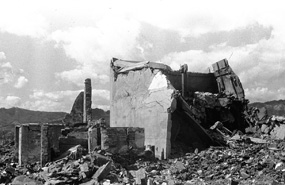 |
| 42 |
The vault at Mitsui Life Insurance, Hiroshima Branch
Approx. 200m from the hypocenter, Nakajima-hon-machi (now, Nakajima-cho)
|
|
The Hiroshima branch of Mitsui Life Insurance burned to the ground, but the vault in the center of the building survived. This building stood where the Children's Peace Monument stands now in Peace Memorial Park.
|
|
|
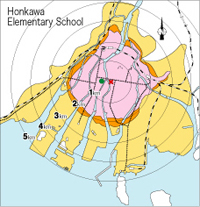 |
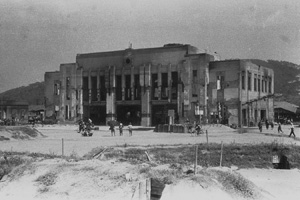 |
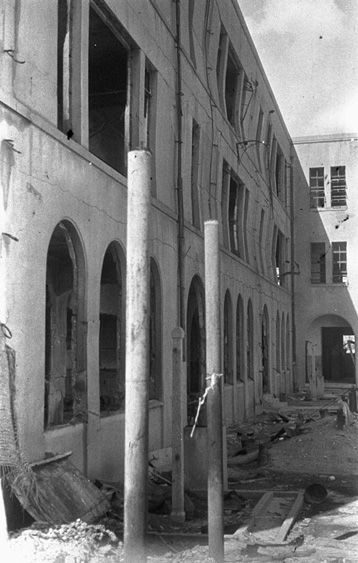 |
| 43 |
Honkawa Elementary School
Approx. 410m from the hypocenter, Kajiya-cho, (now, Honkawa-cho 1-chome)
|
|
Shown is the east wall of Honkawa Elementary School, which faced the hypocenter. The blast indented the wall of the second and third floors into a waveform. Most of the 400 students, 10 teachers, and Hiroshima Prefectural Civil Engineering staff who were using the building at the time were killed. The building was a total loss, but the shell remained. The day after the bombing, it became an emergency relief station that took in hundreds of victims.
|
|
|
Segawa Warehouse
Approx. 550m from the hypocenter, Nakajima-shin-machi (now, Nakajima-cho)
|
|
This two-story ferroconcrete building was crushed. The collapsed roof, floors, and external walls make it look like a one-story building. It was a total loss.
|
| 44 |
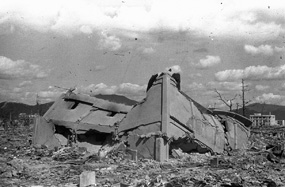 |
|
 |
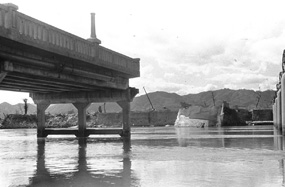 |
| 45 |
Shin-ohashi Bridge
Approx. 620m from the hypocenter, Nakajima-shin-machi (now, Nakajima-cho)
|
|
The Shin-ohashi Bridge was washed out by the Makurazaki Typhoon. A new bridge called Nishi-heiwa-ohashi Bridge was completed in approximately the same position in 1952. On the day of the bombing, thousands of junior high and girls high school students were in the area helping to demolish buildings for fire lanes. Working outdoors so near the hypocenter, nearly all died. Their bodies filled the river.
|
|
|










